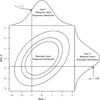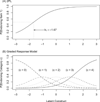Item factor analysis: current approaches and future directions
- PMID: 17402812
- PMCID: PMC3162326
- DOI: 10.1037/1082-989X.12.1.58
Item factor analysis: current approaches and future directions
Abstract
The rationale underlying factor analysis applies to continuous and categorical variables alike; however, the models and estimation methods for continuous (i.e., interval or ratio scale) data are not appropriate for item-level data that are categorical in nature. The authors provide a targeted review and synthesis of the item factor analysis (IFA) estimation literature for ordered-categorical data (e.g., Likert-type response scales) with specific attention paid to the problems of estimating models with many items and many factors. Popular IFA models and estimation methods found in the structural equation modeling and item response theory literatures are presented. Following this presentation, recent developments in the estimation of IFA parameters (e.g., Markov chain Monte Carlo) are discussed. The authors conclude with considerations for future research on IFA, simulated examples, and advice for applied researchers.
(c) 2007 APA, all rights reserved.
Figures





References
-
- Achenbach T, Edelbrock C. Manual for the Child Behavior Checklist and Revised Child Behavior Profile. Burlington, VT: University Associates in Psychiatry; 1983.
-
- Albert JH. Bayesian estimation of normal ogive item response curves using Gibbs sampling. Journal of Educational Statistics. 1992;17:251–269.
-
- Albert JH, Chib S. Bayesian analysis of binary and polychotomous response data. Journal of the American Statistical Association. 1993;88:669–679.
-
- Aptech Systems. GAUSS systems (Version 7.0) Black Diamond, WA: Author; 2003.
-
- Baker FB. An investigation of the item parameter recovery characteristics of a Gibbs sampling procedure. Applied Psychological Measurement. 1998;22:153–169.

